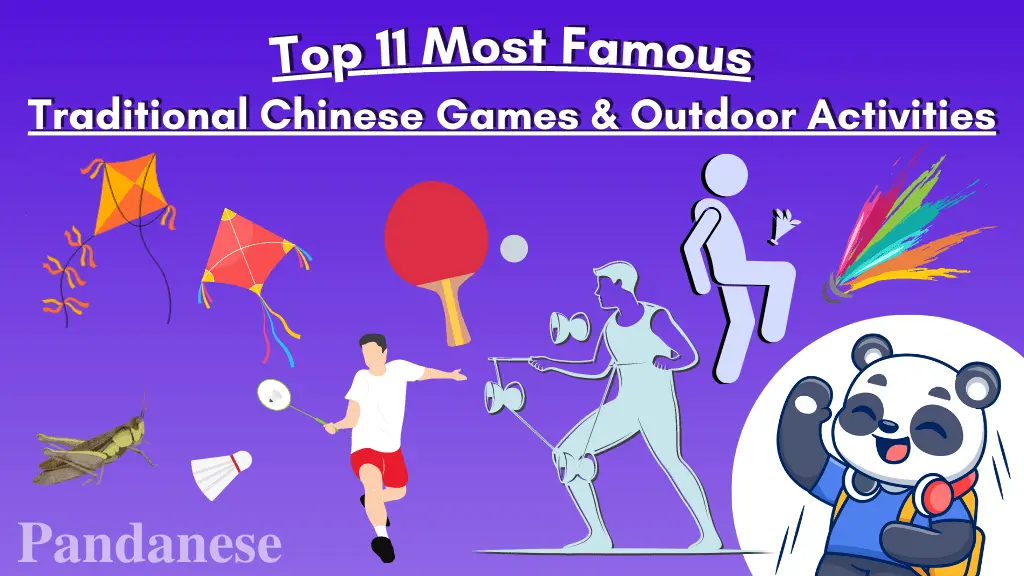
Top 11 Most Famous Traditional Chinese Games and Outdoor Activities
During ancient times, Chinese children didn't have smartphones, iPads, or computers to entertain themselves. Instead, they grew up with traditional games, sports, and activities. Today, despite technological advancement in China, people still keep their outdoor, traditional Chinese games alive.
In this article, we'll introduce you to the top 11 most popular traditional Chinese games—most of which are still widely loved in modern-day life.
毽子 (jiàn zi) Shuttlecock

A person playing jiàn zi, Wikimedia
According to Chinese legends, jiàn zi originated from 蹴鞠 (cuju), an ancient game from the Han dynasty that has been around for over 2,000 years. These traditional Chinese toys are pretty simple, with only one rule: keep the shuttlecock in the air without using your hands. Players mainly try to kick as many as possible, not to drop the shuttlecock. Over the years, various techniques have been developed, from simple kicking to acrobatic heading to powerful overhead kicks. Besides being played in the schoolyard, the shuttlecock is also very popular among senior citizens to keep their limbs active
The two elderly having fun kicking shuttlecock aroundIn China, this traditional Chinese game usually has two main forms: two kickers or two teams playing against each other, like soccer, or in a group of 5 to 10 people circling and kicking the shuttlecock. Shuttlecock has also evolved into a formal traditional Chinese sport. Jiàn Qiu, the competitive, government-run version of jiàn zi, is played on a rectangular court divided by net-like badminton but with kicks instead of rackets.
抖空竹 (dǒu kōng zhú) Chinese yo-yo

A person playing Chinese yoyo, Wikimedia
The Chinese Yo-yo dǒu kōng zhú, also known as diabolo, is an hourglass-shaped toy made of wood or bamboo with a string connected to two hand sticks. The players get the diabolo to balance and rotate by alternating the hand sticks up and down. Highly skilled players can toss the yo-yo up in the air and catch it on the strings or manipulate the strings into patterns while keeping the yo-yo spinning
Tricks on the dǒu kōng zhú (the Chinese yo-yo), Kuma FilmsPlaying diabolo is a fun folk game especially popular in North China. Playing diabolo has evolved into a part of Chinese traditional acrobatics through many changes. This traditional Chinese toy was listed as a National Cultural Heritage in 2006. Diabolo is also played in performances, especially those including acrobatics. The most famous acrobatic troupe, Cirque Du Soleil, performs Chinese yo-yos in several shows.
跳皮筋 (tiào pí jīn) Chinese jump rope

Chinese jump rope demonstration, WikiHow
When you visit China, you'll easily find Chinese parks full of people, both young and old, from dawn to dusk, engaging in many sports, leisure activities, and traditional Chinese outdoor games. One of these activities is 跳皮筋, which literally translates to jumping rubber band and is one of the favorites, as it involves movements and engagement to keep them active and entertained.
The Chinese jump rope features a giant stretched-out rubber band. Unlike the Western jump rope, this game aims to hook your legs into the rope in a specific order to create loops and patterns in a certain sequence. The rope is raised as each level is completed, making the patterns more difficult. A rhyme or song often accompanies this game
Kids playing Chinese jump rope—跳皮筋 (tiào pí jīn)放风筝 (fang fēng zhēng) Flying kites

Chinese kite festival, China Discovery
The Chinese kite is both a traditional folk handicraft and a traditional toy for children around 700 – 476 BC. They were originally designed by the philosopher Mo Zi (or Mao Tse) as a military technology to spy on the enemy's situation from the air.
During the Tang dynasty (618 – 900 CE), kites became a traditional art. Kites are made and flown in the pleasant spring weather, making them a symbol of health and prosperity even today.
Kite flying was declared an official sport in 1991. Regular kite-flying competitions are held annually in several cities across China. On April 20 – 25 each year, the annual Weifang International Kite Festival is held in this “Kite City” in Shandong Province
Annual kite festival in the eastern province of Shandong in 2021, SCMP ClipsDuring this, the top ten out of thousands of participants from China and abroad compete with beautiful and colorful kites in all forms and sizes.
蝈蝈 (guō guō) Grasshopper

Grasshopper in wooden/bamboo cage, Wikimedia
Guō guō is not a game; it is often seen as a toy for young children. As the vibrant green crickets are believed to symbolize good luck and are famous for their “singing.”
Chinese children often find them and keep them in whimsical containers. Some containers are even specifically designed to amplify these tunes. During the summer months, you can easily find them in many markets in China.
乒乓 (pīng pāng) Ping pong

Professional Chinese ping pong: Ding Ning-min
Though Ping Pong is not a Chinese invention, it's one of China's most-played recreational sports, with over 300 million players. This activity is available in almost every schoolyard and is easy to purchase and set up.
Chinese school kids playing ping pongYou don't need to build or pave a court. Ping-pong tables are lightweight and can be folded up to save room.
羽毛球 (yǔ máo qiǔ) Badminton

Kid playing badminton
Badminton is very popular among Chinese kids and is another relatively cheap sport. It is played without a net in many schoolyards, with rules similar to hacky sack. The game aims to prevent the badminton birdie or shuttlecock from touching the ground.
Besides ping pong, the Chinese have also dominated badminton at major international competitions.
皮影戏 (pí yǐng xì) Chinese shadow puppetry

An elderly man holding up one Chinese shadow paper puppet, China Culture
Chinese shadow puppetry, also known as shadow play, originated in the Han dynasty (202 BC – 220 AD). During ancient times, shadow play was the closest thing to watching a film or television for entertainment.
Shadow puppetry includes two-dimensional figures (made of paper, cotton, leather, and other materials) placed behind a screen back, then a thin white cloth. A light source produces shadows on this screen, and the folk artists will then manipulate the figures to tell a story through movements, often accompanied by sung narrations
Behind the scenes of Chinese traditional culture shadow play, Jim TateDuring the Tang (618 – 907), Song (960 – 1279), and Qing (1644 – 1912) dynasties, the shadow play art reached its peak and was staged in most major events. Shadowplay was recognized as a National Intangible Cultural Heritage in 2006 and added to the UNESCO Intangible Cultural Heritage list in 2011.
抓拐 (zhuā guǎi) Knuckle bones

Knucklebones for a game, Mid-autumn Chinese Ancient Festival
Knuckle Bones is one of the most popular traditional Chinese games. This game is very similar to “jacks” in Western culture. 拐 (guǎi) refers to a piece of bone, usually from a sheep or pig's thigh joint. Children often save them from dinner.
Like jacks, a ball or small beanbag is tossed up while playing. Although the rules differ, one of the main goals is to “turn” all four bones right side up before catching the beanbag.
This activity was popular among young ladies in ancient times to improve their finger nimbleness. The more nimble their fingers, the better at the loom and embroidery they would be.
斗蛐蛐 (dòu qū qū) Cricket battling
Though this particular game may offend some animal lovers, it's quite popular in many rural areas in China. The players will put crickets in an enclosed “arena” (usually a clear bowl or box). Then, they will agitate their crickets by prodding their antenna with a stick, causing them to become aggressive. The crickets are forced to fight until one flees, stops chirping, is thrown out of the ring, or is eaten by the other.
Background information for cricket battling, South China Morning PostMany adults also participate in cricket battling; some even grow crickets specifically for fighting. The cricket battling season occurs between August and September, as these insects rarely live through the fall season.
象棋 (xiàngqí) Chinese chess

Xiàngqí board layout, Wikimedia
Xiangqi, also known as Chinese chess, is a strategic board game played between two players on a square board divided into compartments.
Like chess, the objective is to capture the opponent's general while protecting your own. Each player has an army of different pieces, including Generals, Advisors, Elephants, Horses, Chariots, Cannons, and Soldiers, each with its movement and abilities.
Quick and concise explanation of Chinese Chess, Triple S GamesThe game involves attacking, defending, and strategically positioning your pieces to control the board. It is a popular and deeply rooted traditional game in Chinese culture, enjoyed by players of all ages.
Frequently asked questions
What traditional games do Chinese people play?
毽子 (jiàn zi) Shuttlecock
抖空竹 (dǒu kōng zhú) Chinese yo-yo
跳皮筋 (tiào pí jīn) Chinese jump rope
放风筝 (fang fēng zhēng) Flying kites
蝈蝈 (guō guō) Grasshopper
乒乓 (pīng pāng) Ping pong
羽毛球 (yǔ máo qiǔ) Badminton
皮影戏 (pí yǐng xì) Chinese shadow puppetry
抓拐 (zhuā guǎi) Knuckle bones
斗蛐蛐 (dòu qū qū) Cricket battling
象棋 (xiàngqí) Chinese Chess
What games do children in China play?
Here are the top 4 games Chinese children play:
Chinese kites 放风筝 (fang fēng zhēng)
Chinese jump rope 跳皮筋 (tiào pí jīn)
Shuttlecock 毽子 (jiàn zi)
Chinese yoyo 抖空竹 (dǒu kōng zhú)
What are some traditional Chinese outdoor games?
毽子 (jiàn zi) Shuttlecock
抖空竹 (dǒu kōng zhú) Chinese yo-yo
跳皮筋 (tiào pí jīn) Chinese jump rope
放风筝 (fang fēng zhēng) Flying kites
Are Chinese Checkers Chinese?
While Chinese checkers do have a Chinese name called 中國跳棋, they do not originate from China. It was invented in Germany in 1892. Its original name is called Sternhalma.
In closing
These games provide a glimpse into the cultural heritage and recreational pursuits of the past. As technology advances, these traditional games serve as a reminder of the enduring value of outdoor play and cultural traditions in Chinese society.
The easiest way to learn Chinese & build vocabulary

